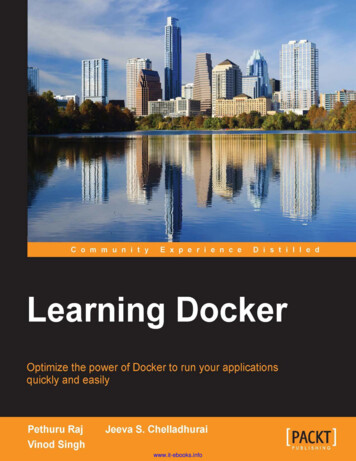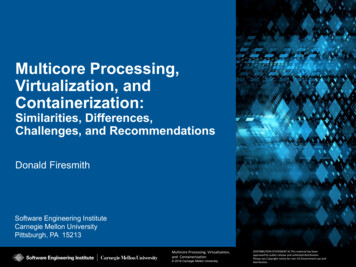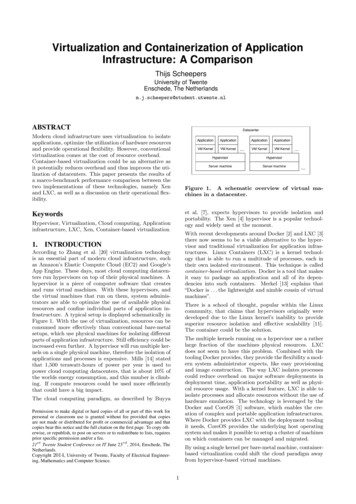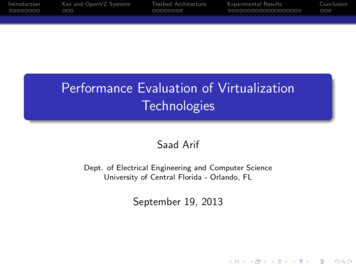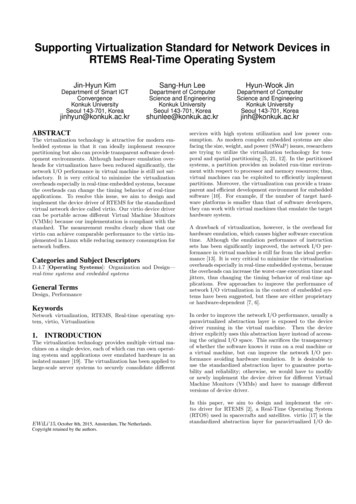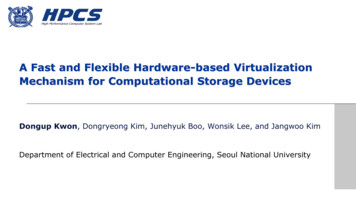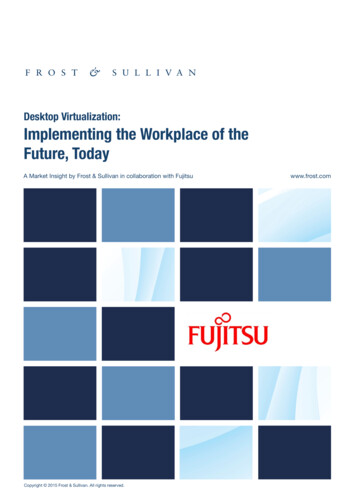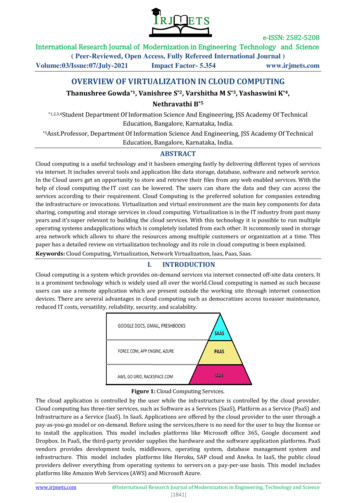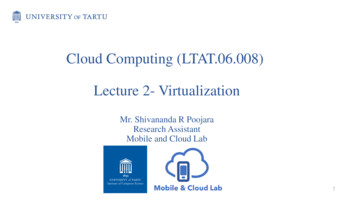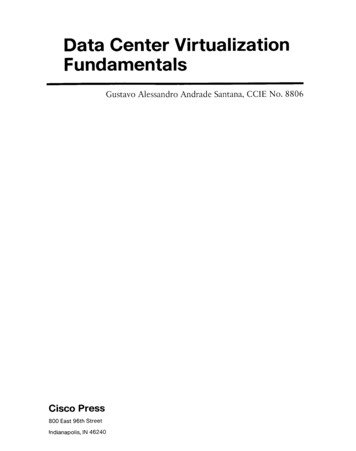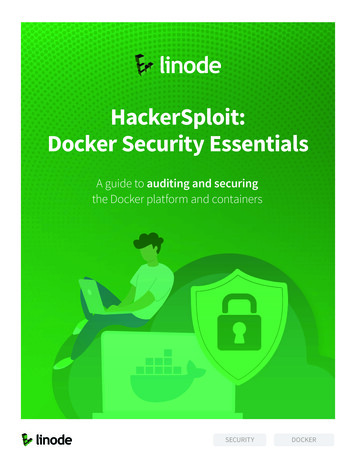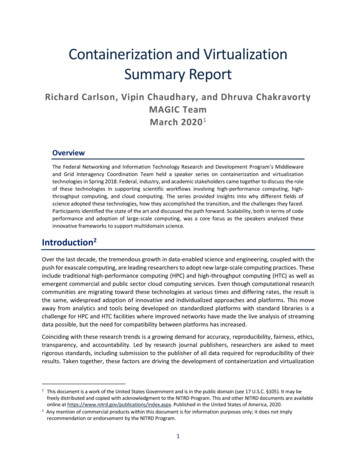
Transcription
Containerization and VirtualizationSummary ReportRichard Carlson, Vipin Chaudhary, and Dhruva ChakravortyMAGIC TeamMarch 2020 1OverviewThe Federal Networking and Information Technology Research and Development Program’s Middlewareand Grid Interagency Coordination Team held a speaker series on containerization and virtualizationtechnologies in Spring 2018. Federal, industry, and academic stakeholders came together to discuss the roleof these technologies in supporting scientific workflows involving high-performance computing, highthroughput computing, and cloud computing. The series provided insights into why different fields ofscience adopted these technologies, how they accomplished the transition, and the challenges they faced.Participants identified the state of the art and discussed the path forward. Scalability, both in terms of codeperformance and adoption of large-scale computing, was a core focus as the speakers analyzed theseinnovative frameworks to support multidomain science.Introduction2Over the last decade, the tremendous growth in data-enabled science and engineering, coupled with thepush for exascale computing, are leading researchers to adopt new large-scale computing practices. Theseinclude traditional high-performance computing (HPC) and high-throughput computing (HTC) as well asemergent commercial and public sector cloud computing services. Even though computational researchcommunities are migrating toward these technologies at various times and differing rates, the result isthe same, widespread adoption of innovative and individualized approaches and platforms. This moveaway from analytics and tools being developed on standardized platforms with standard libraries is achallenge for HPC and HTC facilities where improved networks have made the live analysis of streamingdata possible, but the need for compatibility between platforms has increased.Coinciding with these research trends is a growing demand for accuracy, reproducibility, fairness, ethics,transparency, and accountability. Led by research journal publishers, researchers are asked to meetrigorous standards, including submission to the publisher of all data required for reproducibility of theirresults. Taken together, these factors are driving the development of containerization and virtualization12This document is a work of the United States Government and is in the public domain (see 17 U.S.C. §105). It may befreely distributed and copied with acknowledgment to the NITRD Program. This and other NITRD documents are availableonline at https://www.nitrd.gov/publications/index.aspx. Published in the United States of America, 2020.Any mention of commercial products within this document is for information purposes only; it does not implyrecommendation or endorsement by the NITRD Program.1
Containerization and Virtualization Summary Reporttechnologies that assist researchers in managing and maintaining both their computing and dataresources.The Middleware and Grid Interagency Coordination (MAGIC) Team of the Federal Networking andInformation Technology Research and Development (NITRD) Program held a speaker series oncontainerization and virtualization technologies in the Spring of 2018. Federal, industry, and academicstakeholders came together to discuss and analyze the role of these innovative technologies in HPC, HTC,and cloud computing workflows that support multidomain science. The series and the follow-up MAGICmeeting in May provided insight into why different fields of science are adopting these technologies, howthey are accomplishing the transition, and the challenges they face. As participants identified the state ofthe art and discussed the path forward, scalability emerged as a focus for both code performance and theadoption of large-scale computing.Discussion SummaryContextParticipants analyzed the importance of innovative containerization and virtualization computingframeworks in the following contexts:1. Definition of Container. A container is an operating system within an operating system. Unlike aVirtual Machine (VM), it does not virtualize the processor. As such, there is no overhead fortranslating machine instructions. A container shares the kernel of the host operating system whilespoofing file system and network access via system calls. In contrast to VMs, containers are notviewed as long-running processes.2. HPC and HTC Sites. These sites support modeling and simulation, for both new and experiencedusers, in a variety of disciplines and experiments. A common concern is that researchers needdifferent resources at different times and increasingly require support for data-intensive use cases.Containers can easily run data-intensive analysis or visualization wherever users have access;however, containers are not necessarily amenable to the traditional modeling and simulation model.3. Characteristics and Functions of Containers. Containers give users greater control over theenvironments in which they execute their applications. In the context of large-scale, data-intensiveworkflows, the goal at most sites is to assist users in deploying the container regardless of the site’sunderlying technology. Containers shield users from the underlying complexity of systems. Theyallow users to ensure reproducibility on other machines, and to install arbitrary software as nonroot users (root users have access to all commands and files on an operating system). Communitiescan run their own code on HPC systems, connect to the systems via gateways, and often receiveperformance benefits. However, security concerns increase as these infrastructures becomeavailable to more users.The speaker series was organized into three sessions that provided expert overviews of container servicesin general, in research and education (R&E) workflows, and in large-scale computing platforms.Container ServicesContainers and virtualization technologies have their home in the cloud computing communities wherethere is an operational need to provide users with root-like privileges while reducing the overhead on thephysical hardware. Since commercial clouds provide micro-services to the user and are not designed tosupport HPC and HTC types of research workloads, the first containers were not developed with the needs2
Containerization and Virtualization Summary Reportof researchers in mind. Today, containers provide users with the benefits of VMs, without the overheadsand cloud, and with tight integration to HPC and HTC facilities. By deploying containers, users can focuson developing an application instead of managing their infrastructure. Free scalability, fault tolerance(redeployment capability), and flexibility are core attributes which drive the rapid adoption of containersin the R&E community.Container Services in Research and Education WorkflowsHPC and HTC facilities are successfully deploying containerization technologies for users in a variety ofscientific research fields. For example, in a fundamentally heterogeneous environment, the Open ScienceGrid (OSG)3 creates the appearance of a homogenous environment for users by supporting a variety ofcontainer technologies. Many Federally supported research facilities have successfully deployed thesetechniques including: Extreme Science and Engineering Discovery Environment’s Comet4Laser Interferometer Gravitational-Wave Observatory (LIGO)5National Energy Research Scientific Computing Center (NERSC)6Fermilab’s High Energy Physics Portal (HEPCloud)7Advanced Light Source (ALS)8Earth System Grid Federation (ESGF)9Container Services in Large-Scale Computing PlatformsWhile Docker remains the standard bearer in cloud computing, technologies such as Shifter, Spin andSingularity have emerged to support scientific research workloads. Kubernetes continues to remain theleader in orchestration. Each technology is summarized below.DockerDocker makes possible the widespread adoption of containers in research computing scenarios. Itpopularized the idea of containers as a means for distributing software, performing resourcemanagement, and providing applications for private, customized environments. Dockerfile produces animage, creating a container. That container can be moved around, provisioned at new sites, and executedon different platforms. This makes the building, shipping, and running of applications portable. However,for HPC and HTC environments, there are security and storage-based challenges. For example, with its “allor nothing” security model, once a user runs a Docker container, they are given full system privileges; inshared environments where a batch system manages nodes and a file system manages storage, Dockercan be problematic.SingularitySingularity is a container technology that is designed specifically for scientific computing. Developed atDOE’s Lawrence Berkeley National Laboratory, it allows users to have full control of their f.llnl.gov/43
Containerization and Virtualization Summary Reportand to use containers to package scientific workflows, software, libraries, and even data. It is compatiblewith both Docker images and complicated HPC architectures. Its images can be archived and managed asdata, and its security model is designed to support untrusted users from untrusted containers.Singularity’s image format allows for global header and object descriptors to reference raw data objectswithin the file, enables cryptographic signatures for data objects, and adds a signature block as a dataobject. This allows for changes to be monitored. A user can also ensure software reproducibility by copyinga container, a feature which is ideal for journal publications.ShifterShifter is a container technology developed at NERSC. It leverages the Docker image ecosystem whileallowing users to securely run containers in an HPC environment with access to a shared file system andhighspeed network. Shifter can be integrated with a workload manager as well.SpinSpin was also developed at NERSC. It is a container technology that provides a flexible system to build anddeploy science gateways, workflow managers, and “edge services” quickly using Docker containers.Everything is built from containers that are software-defined; resources can be spun up quickly and areeasy to manage. Spin also offers opportunities to deploy entire stacks in batch job prologue via applicationprograming interface (API) calls.KubernetesKubernetes is an open-source platform designed to automate and orchestrate the deployment, scaling,and operation of application containers. It currently operates as a managed service on Amazon, Google,and Azure cloud platforms. It is suitable for projects that need to control their own applications and dataand performs well for certain workloads.OpenStackOpenStack provides infrastructure as an abstraction. OpenStack Ironic provisions bare metal machines andis used in the Chameleon Cloud. Container-hosted OpenStack services, such as OpenStack Ansible, areinfrastructure containers that have privileged system access and provide infrastructure support andmanagement.AWSAWS is a commercial cloud provider and uses containers at scale via Elastic Container 2 (EC2) instances.AWS envisions a future in which EC2 returns to tasks and essentially deconstructs containers.ConclusionThere is a growing need to support diverse compute requirements in scientific research computingenvironments. Containers and virtualization technologies assist researchers in meeting computationalneeds, and there has been significant progress in developing the underlying technology andunderstanding the critical operational requirements. These technologies will continue to be developedwith open-source software, security, and easy integration into current large-scale computing sites.Usability is driving demand. The growth of these tools in the academic, government, and private sectorsshows tremendous promise. Improved cross-sector collaboration and cooperation, as well as engagementwith standards bodies, will help bridge the existing differences between science and commercial use.Ideas for further discussion include:4
Containerization and Virtualization Summary Report Management and operations support that includes provisioning, integration, balancing, open APIs,authentication, monitoring, self-healing, resilience, reliability, availability, and data analytics. Policies for interoperability, trust, verification, and authentication that do not impact usability. Forums for collaboration, progress assessment, tool sharing, test suite development, workforcedevelopment, and training. Innovative tools for multi-tenancy and real-time access controls to enforce security policies.About the AuthorsThe NITRD Program is the Nation’s primary source of federally funded work on pioneering informationtechnologies (IT) in computing, networking, and software. The NITRD Subcommittee of the National Scienceand Technology Council’s Committee on Science and Technology Enterprise guides the multiagency NITRDProgram in its work to provide the R&D foundations for ensuring continued U.S. technological leadershipand meeting the needs of the Nation for advanced IT. The National Coordination Office (NCO) supports theNITRD Subcommittee and the Interagency Working Groups (IWGs) and Teams that report to it. The NITRDSubcommittee’s Co-Chairs are Kamie Roberts, NCO Director, and Margaret Martonosi, Assistant Director ofthe NSF Directorate for Computer and Information Science and Engineering. More information about NITRDis available online at http://www.nitrd.gov.The MAGIC Team was established in 2002 and provides for information sharing among Federal agenciesand non-Federal participants with interests and responsibility for middleware, grid, and cloud projects;individuals involved in middleware, grid, and cloud research and infrastructure; individuals involved inimplementing or operating grids and clouds; and users of grids, clouds, and middleware. The MAGIC Teamreports to NITRD’s Large Scale Networking (LSN) IWG. More information is available online ntsThe National Coordination Office for the NITRD Program gratefully acknowledges MAGIC Co-chairs RichardCarlson (DOE) and Vipin Chaudhary (NSF); Dhruva Chakravorty (Texas A&M University); guest presenters;and the members of the MAGIC Team who helped plan and implement the Containerization andVirtualization Technologies Speaker Series and write and review this report5
Characteristics and Functions of Containers. Containers give users greater control over the environments in which they execute their applications. In the context of large-scale, data-intensive workflows, the goal at most sites is to assist users in deploying the container regardless of the site's underlying technology. Containers shield users .
